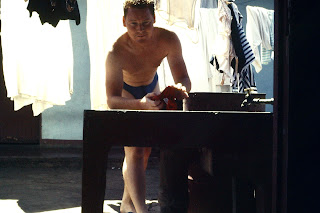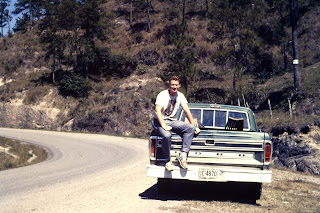Wednesday 27th January 1988
The alarm clock proved trustworthy, but we had a bit of trouble getting someone to let us out of the locked-up hotel at 03:30 hrs. Eventually, the doorman emerged smiling and yawning to let us out into the street and we walked down to the Bus Station.
The streets were deserted except for a couple of caterwauling cats attacking each other. The few locals that we saw were wrapped up warm, one with a soup tureen over his head like a helmet!
There was only one bus and we got on it. It left punctually at 04:00 hrs. and raced along good roads towards Nicaragua. We slept for the first two hours and then woke to a spectacular dawn. The scenery was desert plain with scrub trees and distant hills. The wind howled around the bus like a banshee.
We saw more bicycles on the road than usual and slowed down a couple of times due to cattle in the road, them being herded by cowboys. We passed through Choluteca which is a municipality and the capital city of the Honduran department of the same name. Situated in southern Honduras between El Salvador and Nicaragua, the city is generally considered the regional centre of southern Honduras and is a major transit point on the Pan-American Highway.
When Spanish conquistadors arrived in southern Honduras in 1535, the Chorotega indigenous people inhabited the area. In 1541, a town was founded there by Captain Cristobál de la Cueva which was known as Villa de Xerez de la Frontera de Choluteca.
We continued on through San Marcos de Colón which is a town, with a population of 12,870 (2020 calculation), and a municipality in the Honduran department of Choluteca, located on the border with Nicaragua. The town is located on the Pan-American Highway near the Nicaraguan border town of Somoto, and 192 km (119 miles) away from the capital Tegucigalpa.
Both of the towns were both pleasant looking, quiet simple places. At last, we went uphill and stopped at a preliminary checkpoint followed by Honduran Customs. We were quickly stamped out of Honduras and we set off downhill to the ghost town of El Espino.
We were the only people, so we continued through the deserted buildings with the intention of walking the 5 kilometres to the first Nicaraguan checkpoint. We passed a sentry post with stencilled Sandinista propaganda and walked along the deserted road between hills that looked like the film set for a Western.
A truck pulled up alongside us and a soldier with an AK47 jumped out and indicated that we should return to El Espino with him in a passing pickup truck.
The AK-47, officially known as the Avtomat Kalashnikova (Russian: Автома́т Кала́шникова, lit. 'Kalashnikov's automatic rifle'; also known as the Kalashnikov or just AK), is a gas-operated assault rifle that is chambered for the 7.62×39mm cartridge.
Developed in the Soviet Union by Russian small-arms designer Mikhail Kalashnikov, it is the originating firearm of the Kalashnikov (or "AK") family of rifles. After more than seven decades, the AK-47 model, and its variants remain the most popular and widely used rifles in the world.
The number "47" refers to the year the rifle was finished. Design work on the AK-47 began in 1945. It was presented for official military trials the following year in 1947, and, in 1948, the fixed-stock version was introduced into active service for selected units of the Soviet Army. In early 1949, the AK was officially accepted by the Soviet Armed Forces and used by the majority of the member states of the Warsaw Pact.
The model and its variants owe their global popularity to their reliability under harsh conditions, low production cost (compared to contemporary weapons), availability in virtually every geographic region, and ease of use. The AK has been manufactured in many countries and has seen service with armed forces as well as irregular forces and insurgencies throughout the world.
Back at El Espino we went into the old, abandoned Customs Checkpoint and were given a preliminary check of our passports and proof that we had at least $200 US. We then waited in another pickup for sufficient passengers for a worthwhile trip to the proper Emigration Point.
The old Duty-Free shop by the van looked sad and was half collapsed. It cost us 5,000 Nicaraguan Córdoba’s each for the drive to a series of sheds for our passports to be stamped and our luggage cursorily checked. The córdoba is the currency of Nicaragua. It is divided into 100 centavos. At this time there were C$20,000 to the $US Dollar. We then passed a final sentry post and joined a group of people who appeared to be waiting for some sort of transport.
Soldiers in a variety of uniforms, mainly rag-tag, loitered around and a donkey came along to supply them with milk from two urns on it’s back. At the Immigration Caravan we had presented our passports to an invisible being behind a net curtain, and stood waiting expectantly in the howling, dust-carrying, swirling wind.
They puzzled about the whereabouts of, or even the existence of a country called Ireland and concluded that it must be Northern Ireland where Declan earned a living as a Vendedor de Queso (He had worked as a delivery driver for French Dairy Farmers in West London before leaving for Mexico).
We also had to change 60 American Dollars into Nicaraguan Córdoba’s at 20,000 per $ dollar and came away with a huge wadge of C$ 1,200,000 Nicaraguan Córdoba’s.
At last, a battered old minibus, well passed it’s best, came rattling along the road. Surprisingly an orderly queue formed, and we all filed aboard the bus. It was full up when we set off for Somoto, but it didn’t stop them cramming on a few dozen more along the way.
We stopped once while a ragtag bunch checked the papers of the locals, led by an authoritarian looking man in a camouflage uniform. Contorted and cramped we eventually pulled into the dusty yard that served as a bus station for Somoto.
The 30-minute journey cost us C$1,000 Córdoba’s, plus C$1,500 Córdoba’s for our luggage. This is apparently a quirk of Nicaraguan bus travel, that people go cheaper than bags.
Somoto was a dry, dusty frontier town with a pleasant atmosphere. Somoto was settled by Olmec and Aztec peoples from Mexico, and subsequently inhabited by Chorotegas and Nicaraguas. The name Somoto originates from the Nahuatl Tépecxomotl, meaning 'Valley of Geese', while Spanish royal decrees of 1591 give the city's name as Santiago de Tepesomoto. Although the city is now universally known as Somoto, the name Tepesomoto is retained by the volcano overlooking the city to the south and its surrounding Tepesomoto-La Patasta Nature Reserve.
Somoto was granted town status in January 1867 and city status in March 1895. It has been the capital city of Madriz since that department's separation from Nueva Segovia in November 1936.
We booked into the Hotel Panamericano, just off the main plaza, where a double room cost C$24,000 Córdoba’s. We then had the Comida Corriente at the restaurant opposite on the other side of the plaza for C$8,000 Córdoba’s. This was a nourishing dish of rice, refried beans, meat and potato, served with a cup of pineapple juice.
We moved on to the Comedor of the Hotel Internacional for a couple of beers at C$7,000 Córdoba’s each. Unfortunately, we had to put up with an unsolicited monologue on the state of Nicaragua from a Swiss traveller.
There are a wealth of soldiers in town, most of them young, from the army camp adjacent to the plaza, opposite the rugged white church. Somoto's adobe parochial church, formally the Temple of Saint James the Apostle (Templo Santiago Apostól), was established in the heart of Somoto in 1661 opposite the city's parque central It is therefore one of Nicaragua's oldest surviving church buildings, pre-dating the Cathedral of León by 86 years. However, the present façade and bell tower were constructed as recently as 1875.
Somoto is also located near the Cacaulí Sanctuary, a site for religious pilgrimage since a boy claimed to have seen the Virgin Mary while collecting firewood in 1990 (She must have heard that we were there a couple of years previously).
Our next move was to buy tickets for tomorrows 06:00 hrs. “Express Bus” to Managua. These were purchased from the dingy village store one block down from the bus station. We returned to the hotel to do some washing and hung it out to dry in the back yard in a stiff breeze.
We then settled down to catch up on some sleep in our dimly lit room. It remained dim even after replacing the light bulb when the old one blew.
For the evening meal we crossed the square to the Hotel Internacional Restaurant for a good meal. We had rice, eggs, beans, cheese, fried banana and tortilla. We also had a couple of Toña beers, cerveza hecho en Nicaragua. Toña Cerveza is a Lager - Adjunct style beer 4.6% abv brewed by Industrial Cervecera S.A. / Compañía Cervecera De Nicaragua in Managua.
Current advertising says “Nicaragua is famous for many things, but none more celebrated than Toña’s smooth, easy-drinking flavour. So, pet that puma, befriend a pirate, and hike up a volcano—there’ll be a well-earned Toña waiting for you at the top”.
We were joined by the friendly old manager who talked detrimentally about American politics and gave us a few cooking tips. We popped into the telephone place and confirmed that it was the equivalent of $8 US dollars to telephone England.
We crossed the square with a family of pigs and the chains of the swings in the playground creaked eerily in the wind. The night was tranquil with fast-moving clouds flitting across the stars.








































